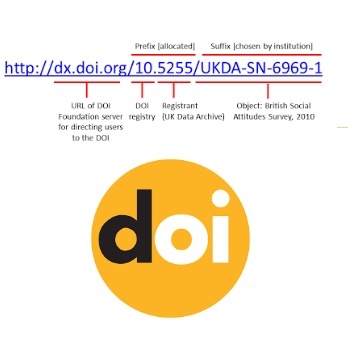Why do we need Permanent Unique Identifiers?
29/06/2017

.jpg)
(Source: The case for Digital Objects Identifiers (DOIs) in support of research activities, SlideShare)
A persistent identifier (or permanent Identifier or handle) is one that never changes, so that your bookmarks and links don't break when a website gets updated. DOI (Digital Object Identifier) is a permanent identifier used to uniquely identify objects. A DOI aims to be "resolvable", usually to some form of access to the information object to which the DOI refers...
_________________________________________________________________________________________________________________
... This is achieved by binding the DOI to metadata about the object, such as a URL, indicating where the object can be found. Thus, by being actionable and interoperable, a DOI differs from identifiers such as ISBNs and ISRCs which aim only to uniquely identify their referents ...
DOIs are in wide use to identify a published digital object, such as an article or a study, research reports and data sets. If you're accessing an article, you'll probably be forwarded to a reference service like JStor or ProQuest, and if your campus has a subscription with that service, you should be able to access the full text. In other words, DOIs also have built-in OpenURL functionality.
|
Here is an example of a citation for an academical study with a DOI: Deschenes, Elizabeth Piper, Susan Turner, and Joan Petersilia. INTENSIVE COMMUNITY SUPERVISION IN MINNESOTA, 1990-1992: A DUAL EXPERIMENT IN PRISON DIVERSION AND ENHANCED SUPERVISED RELEASE [Computer file]. ICPSR06849-v1. Ann Arbor, MI: Inter-university Consortium for Political and Social Research [distributor], 2000. doi:10.3886/ICPSR06849 The DOI in this example is 10.3886/ICPSR06849 and it links to the URL: |
DOIs are concise and easy to include in a citation and their adoption promotes access and reusability of data in modern research.
DOIs are also part of an integrated network of linkages between articles and datasets that is maintained by publishers and repositories through registration agencies like CrossRef.
The inclusion of DOIs in citations makes it much easier for your campus to see how a report or dataset generates other research, which in turn assists researchers in demonstrating the value and scientific impact of their work.
|
Take the most out of the past Webinar@AIMS “The case for Digital Objects Identifiers (DOIs) in support of research activities” (recording) The webinar begins with some basic concepts on Permanent Unique Identifiers. For more information contact: Marco Marsella ([email protected]) |
... A number of referencing styles (including APA 6th, Chicago, and Vancouver) require that you include DOIs for publications where they have been assigned. This guarantees that others will be able to access your listed references, as DOIs offer persistence and permanence.
To check if DOIs are used with your required referencing style, see e.g., University of Newcastle Library style guides.
All that means that accurate identification of the subject of the research (as well as of the techniques and methods used) is critical to obtain reliable results ...
... Following on from this :
|
“How do I get a DOI for my survey? DOIs are created/registered by publishing organizations, not by individuals. If you deposit your data with us, we'll assign a DOI for your study and it will appear in the citation on our website and in downloads. How do I get a DOI for my report or article? The journal/publisher of the article should assign the DOI. If your publisher isn't registering DOIs, you should encourage them to do so. The CrossRef website has useful information on how to get started. How do I use DOIs? Include them in your footnotes and references. Just copy and paste the citation, as you normally would, along with the DOI. By properly citing the data and including the DOI, you're giving proper credit to the investigators who conducted the research and giving the scholarly community a clearer picture of the impact of the research. How do I demonstrate the impact of a study I've deposited with [YOUR INSTITUTION]? The related literature link, available with each study, connects to a list of all the publications based upon your study that [YOUR INSTITUTION] has been able to find. DOIs enable [YOUR INSTITUTION] to harvest those citations more easily, because publishers submit these linkages to the DOI repositories, and [YOUR INSTITUTION] can capture them from there. If you want to help the process along (to build a complete list of citations), please
|
Learn more about DOIs:
- The DOI® System
- Make your work permanent and trackable with unique identifiers
- DOIs are used as Permanent Unique Identifiers (PUID) in the context of the Global Information System (GLIS) of Article 17 of the International Treaty on Plant Genetic Resources for Food and Agriculture (ITPGRFA).
- DOI as the basis for the upcoming Global Information System on Plant Genetic Resources
- Guidelines for the optimal use of Digital Object Identifiers for germplasm samples
- Permanent Unique Identifiers for germplasm (slides)
Related content:
- FAIR Principles – review in context of 4TU.ResearchData
- Use oaDOI link and find an open version of the article
- Unpaywall : find open access versions of paywalled articles
- Why does ORCID matter ?
- Collect & Connect: ORCID’s integration and engagement program
- Oceanographic Data and Information Exchange
